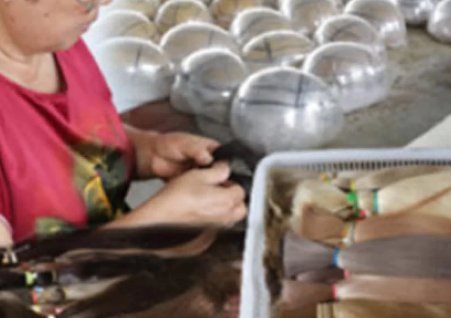
Human hair wigs have come a long way. They sit lightly on your head, move with the breeze, and feel just like your own strands on a good day. If you've ever wondered what goes into turning raw hair into that seamless piece, you're in the right spot. This guide walks you through the whole process of making human wigs. We'll cover every step, from picking the hair to the final trim. It's all about giving you a clear picture—so you can pick a wig that fits your life, boosts your confidence, and turns heads for the right reasons.
Think about it. A well-made wig isn't just hair glued on a cap. It's a blend of skill, patience, and attention to tiny details. For folks dealing with hair loss, or anyone chasing that effortless style, knowing the behind-the-scenes work builds trust. It shows why some wigs last years while others fade fast. Let's dive in.
The journey starts far from the factory floor. Good wigs demand top-notch human hair. No shortcuts here. Suppliers hunt for strands that are strong, shiny, and full of life. Most comes from places like India, China, or Europe—regions known for healthy donor hair.
Hair doesn't just appear. Donors give it willingly, often after growing it long for cultural or personal reasons. Factories like those behind quality wigs stress fair pay and clean practices. This keeps the hair pure. No chemicals taint it early on. You end up with virgin hair—untouched and ready to shine.
Short fact: Ethical sourcing cuts down on tangles later. Donors get compensated right, and the hair stays in its natural cuticle direction. That means less shedding down the road.
Once collected, the hair piles up in bundles. Workers sort by length, color, and texture. Thick Indian hair goes one way. Fine European locks head another. They wash it gently—think mild soaps and cool water. No harsh bleaches yet.
Then comes de-tangling. Combs glide through, group by group. They check for damage. Weak spots get trimmed. The goal? Even bundles that blend smooth. This step takes days. It's tedious but key. Clean hair dyes better and knots tighter.
· Length sorting: From 8 inches to 30—whatever the order calls for.
· Color matching: Natural blacks, browns, or highlights pulled early.
· Texture check: Straight, wavy, curly—grouped to match customer dreams.
By the end, you've got sorted packs. Ready for the next big move.
A wig's base is like the scalp underneath. Get this wrong, and nothing sits right. It's the mesh or skin that holds everything. Breathable? Check. Invisible? You bet. Factories pick materials based on how it feels against skin.
Lace bases lead the pack for that natural look. Fine nets let skin peek through at the front. Mono filaments add stretch—great for all-day wear. Skin bases mimic a real scalp, super discreet under hats.
Here's a quick rundown in a table. It shows how they stack up for everyday use.
Base Type | Breathability | Natural Look | Durability | Best For |
Lace (Swiss/French) | High | Excellent | Medium | Front hairlines |
Monofilament | Medium | Good | High | Full coverage |
Skin/PU | Low | Very Good | High | Discreet blending |
Each has its spot. Lace shines for edges. Skin holds up in heat. Mix them for custom fits.
Workers trace a head shape on paper first. Measure the circumference—around 21-23 inches for most. They cut the material to match. Scissors snip precise lines. No bunching here.
For lace, they hand-sew reinforcements at the edges. This stops fraying. Mono gets woven threads for flex. Skin bases get a thin coat—clear and sticky. The base dries flat. Ready for hair.
This part hums with quiet focus. One wrong cut, and it all starts over. But when done right, it hugs the head like it belongs.
Now the magic happens. Ventilating means knotting hair strand by strand. It's old-school craft, done by hand. No machines rush this. A hooked needle pulls single hairs through the base. Tiny knots secure them. Repeat. Thousands of times.
Single knots sit flat—ideal for lace fronts. They blend into skin easy. Double knots bulk up the back. Stronger hold, less slipping. Workers switch based on the spot. Front? Singles all the way. Crown? Doubles for volume.
Picture a skilled knotter at work. Hook in, hair through, twist, pull. One strand. Then another. It takes weeks for a full wig. That's why rush jobs cost extra—they pull extra hands.
· Tools needed: Ventilation needle, clamp stand, hair bundle.
· Pace: 100-200 knots per hour, depending on density.
· Density levels: Light for fine hair, heavy for thick styles.
This step defines quality. Tight knots mean no shedding. Loose ones? Hair falls out fast. Pros aim for even rows. Part lines look real. Scalp shows through just right.

Hair's on the base. Time to shape it your way. Customers call the shots here. Want waves? Straight silk? It's all possible.
Length gets trimmed first. Scissors follow a template—bob or long layers. Color comes next. Dyes soak in soft. No frying the ends. Textures curl with rods or flat-iron straight.
Remy hair keeps cuticles aligned. Dyes even. Virgin stays raw—wash and go. Blends mix types for grey streaks or highlights.
Short tip: Test a sample first. Colors shift in sun. Textures soften over time.
This phase personalizes. A mom needs easy wash. A performer wants bold curls. Factories note it all. Deliver a wig that feels like you.
Almost there. The wig goes under lights. Stylists comb through. Check knots. Tug edges. Wash a test piece—does it tangle?
Quality teams measure density. 120% feels full. 180%? Plush. They style it—blow-dry, curl. Package gentle. Tags note care tips.
This wrap-up seals the deal. A solid wig lasts 1-2 years with love. Poor ones? Months. That's the gap.
Before we tackle some common questions, a quick nod to the folks who make this happen. Qingdao Eminent Hair Products Co., LTD stands out as a trusted wig supplier. Based in Qingdao, China, they've got years under their belt crafting custom human hair pieces. With a team of about 50 factory hands and 500 skilled knotters, they handle everything from sourcing to final knot. Their focus on ethical hair, quick turns—around 6-8 weeks standard, 4-5 for rushes—and worldwide shipping keeps customers coming back. It's that blend of craft and speed that elevates their work.
Going through the whole process of making human wigs shows real care. Each step builds trust. You get a piece that moves natural, stays put, and lifts your day. It's more than hair—it's confidence in a cap. Whether for daily wear or special nights, a thoughtful wig changes things. Pick one made right, and you'll feel the difference.
It kicks off with sourcing ethical donor hair, then sorting and cleaning. Next, build the base—lace or skin for comfort. Ventilate by hand-knotting strands tight. Customize length, color, texture to fit. End with quality checks and styling. Takes 6-8 weeks total, but it's worth it for a wig that lasts.
Most custom jobs run 6-8 weeks. That's from design to door. Rush options cut it to 4-5 weeks if you're in a pinch. Knotting eats the most time—hand work can't hurry.
Absolutely. Remy keeps cuticles smooth for shine. Virgin skips processing—pure and versatile. Suppliers mix in Indian thick waves or European fine straights. Pick what matches your vibe.
The base is the backbone. Lace breathes easy for all-day wear. Skin blends seamless. Get it right, and the wig sits light, looks real. Wrong choice? Itch or slip.
Checks happen at every turn. Sort hair clean. Knot even. Test wash for tangles. Final tug ensures no loose ends. This keeps your wig shedding-free and true to style for months.
The quality of the products is the foundation of our existence!Customers'satisfaction is our permanent commitment!